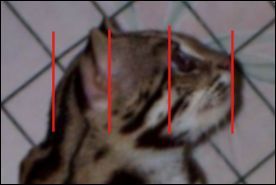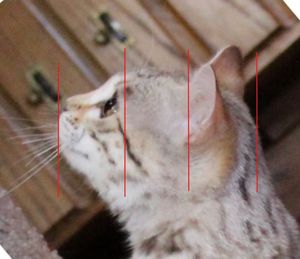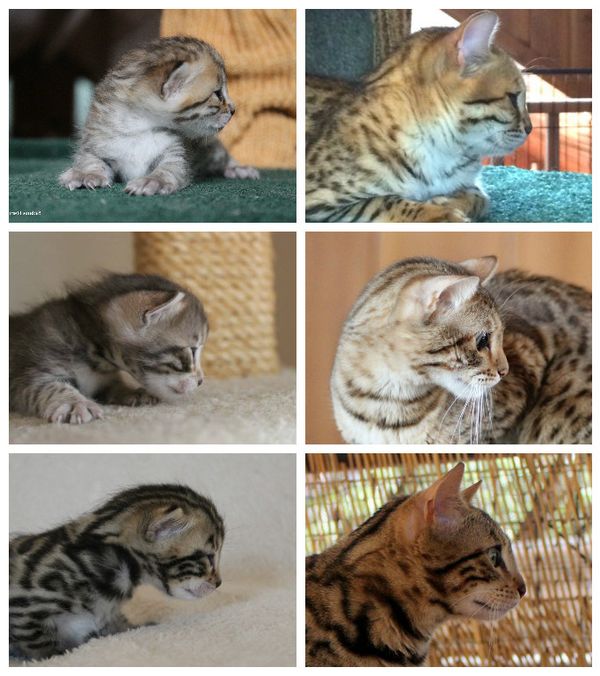 The middle third of the Rule of Thirds is likely the most difficult section to write about because in the middle third, it is more about what you do NOT want to appear there than what you do want to appear there. Notice in the picture of the ALC, the eyes are in the first third and the ears are in the last third. That is exactly as it should be, but it doesn't leave any obvious facial feature for the middle third.
The middle third of the Rule of Thirds is likely the most difficult section to write about because in the middle third, it is more about what you do NOT want to appear there than what you do want to appear there. Notice in the picture of the ALC, the eyes are in the first third and the ears are in the last third. That is exactly as it should be, but it doesn't leave any obvious facial feature for the middle third.The Bengal standard states the the head should be longer than it is wide. I often see people misinterpreting head length with muzzle length. Only one third of the length of the head should be in the muzzle. The other two thirds should all be behind the eyes - with one third being from the eye to the ears.
 On this middle third, otherwise known as the forehead, you want to try to keep an even sweep to the skull from the nose bridge up over the head and into the back skull. If you look around at Bengal cat adults, you will often see a change of direction above the eyes as the forehead flattens out. This is something to avoid when trying to achieve the skull shape of the ALC. Some Bengals go the the extreme of having a dent in the skull here. It looks as if someone has taken their thumb and pushed the skull in above the eyes. This is not desirable.
On this middle third, otherwise known as the forehead, you want to try to keep an even sweep to the skull from the nose bridge up over the head and into the back skull. If you look around at Bengal cat adults, you will often see a change of direction above the eyes as the forehead flattens out. This is something to avoid when trying to achieve the skull shape of the ALC. Some Bengals go the the extreme of having a dent in the skull here. It looks as if someone has taken their thumb and pushed the skull in above the eyes. This is not desirable.In order to achieve a nice forehead with proper length (one-third of the skull) and a smooth continuous flow from beneath the eyes back up over the head, one has to start training their eyes on what to look for in little kittens. If you pick a kitten head that looks like we want it to look as an adult head, you will not achieve enough curvature and length in the middle third section of the head once the kitten matures into an adult.
 Instead, look for kitten who has a lot of forehead. Look for kittens whose forehead goes UP from a distance above the eyes and ears. Kittens who have exaggerated foreheads will develop into adult cats who have the correct, continuous roll over from the nose bridge all the way through to the back skull. They will not develop a change of direction or the dreaded thumbprint indent on the forehead.
Instead, look for kitten who has a lot of forehead. Look for kittens whose forehead goes UP from a distance above the eyes and ears. Kittens who have exaggerated foreheads will develop into adult cats who have the correct, continuous roll over from the nose bridge all the way through to the back skull. They will not develop a change of direction or the dreaded thumbprint indent on the forehead.In the collage to the left, you can see three side by side comparisons of the three different Bengal cats as infant kittens and as adults. Look carefully at the space between the eyes and ears. Notice how, in kittens, the forehead height is extreme.
Next, look below at the pictures of the ALC kitten head and the domestic kitten head. Notice how much more forehead the ALC kitten has above its eyes than the domestic kitten. In picking out Bengal kittens, look for more forehead.

Working on the middle third of the Bengal skull means keeping the features of the face out of this third of the skull. You've got to keep the eyes in the first third and the ears in the last third which leaves the middle third bare - exactly as it should be. Next, you've got to watch the foreheads of baby kittens. Do not pick the kitten who has a correct adult head as an infant. Pick the kitten with extreme height in the forehead, so that as the kitten grows and develops, it doesn't develop a change of direction at the brow line, or, worse, the thumb print indent.




